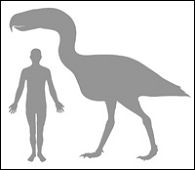
When birds ate us.
Not so long ago, well a few millions years ago, there was a bird that was the absolute master of its world.
Today we consider the eagle to be the ultimate predator and top of the food chain, and rightly so, as there is no other bird or beast that can master it or regularly use it for food.
But between two and sixty million years ago, just before modern man walked upon the earth there was a bird so ferocious it struck fear into most living creatures.
Our ancestors were still hairy apes that walked along the edge of the forests and struck out across the grasslands in search of food. But if you were a hairy ape in South America you had better keep an eye out for a certain bird, as bird-watching in those days would have been a matter of life or death!
There was a whole family of Terror Birds, but the largest, Titanis Waleri, was huge, it stood nearly ten feet tall and weighed in at 330lbs, nearly 24 stone; twice the weight of a normal man. Its beak was enormous and sharp; strong and heavy enough to rip the head off its prey, which don’t forget were our ancestors.
This bird did not fly. It grew so big that they didn’t need to. They were built very much like the ostrich we know today, but had a ferocious beak that can only be described as somewhere between a giant chisel and a sledge hammer.
Scientists are great; they know loads of stuff. They know for sure that North America and South America were once two different continents and eventually crashed together 3.5 million years ago (if you can call colliding at 2cm a year crashing) to form what we know now; the two big bits of America joined together by that skinny bit in the middle.
Terror Birds crossed over this skinny bit long before they joined up. Scientists know this for a fact because they analysed the distribution of a group of chemicals, known as rare earth elements, within the bones, and they were able determine the age of the North American remains. Then they argue about how such a big flightless bird could cross those oceans; did it hop from island to island or did it float on some raft, just like iguanas and other creatures are known to have done?
It was the age of huge mammals. The dinosaurs had come and gone and mammals quickly filled the gap. There were giant sloths bigger than any modern bear. There were elephants nearly three times the size of the elephants we know today, with downward pointing tusks designed to strip bark of trees. There were giant sabre-toothed cats that would make a Bengal tiger look like a pussy. But most predators at the time were normal dog-like creatures that hunted the normal size herbivores, and these were fair game for the Terror-birds, with the odd hairy ape thrown in vary their diet.
Hairy apes (scientists don’t refer to them as humans yet) were leaving the forests and walking upright across the grasslands in search of food. Standing upright had many advantages; you could look over the high grasses in search of prey and hopefully see and evade whatever was trying to eat you. Standing up on your back legs also left your front limbs free to carry tools and weapons, like sticks and stones, which were becoming more and more a part of ape life. These open grasslands had food aplenty for our ape-like ancestors; seeds, roots and an endless supply of meat from grazing animals. But this was the hunting ground of the Terror-birds and no ape stood a chance against this giant ferocious bird which could run at 50mph. Just one peck could split your head wide open.
So next time you are sitting down to a chicken dinner, spare a thought for the Terror-bird, a cousin of your dinner that could have eaten you.
Tommy Byrne.June 2009